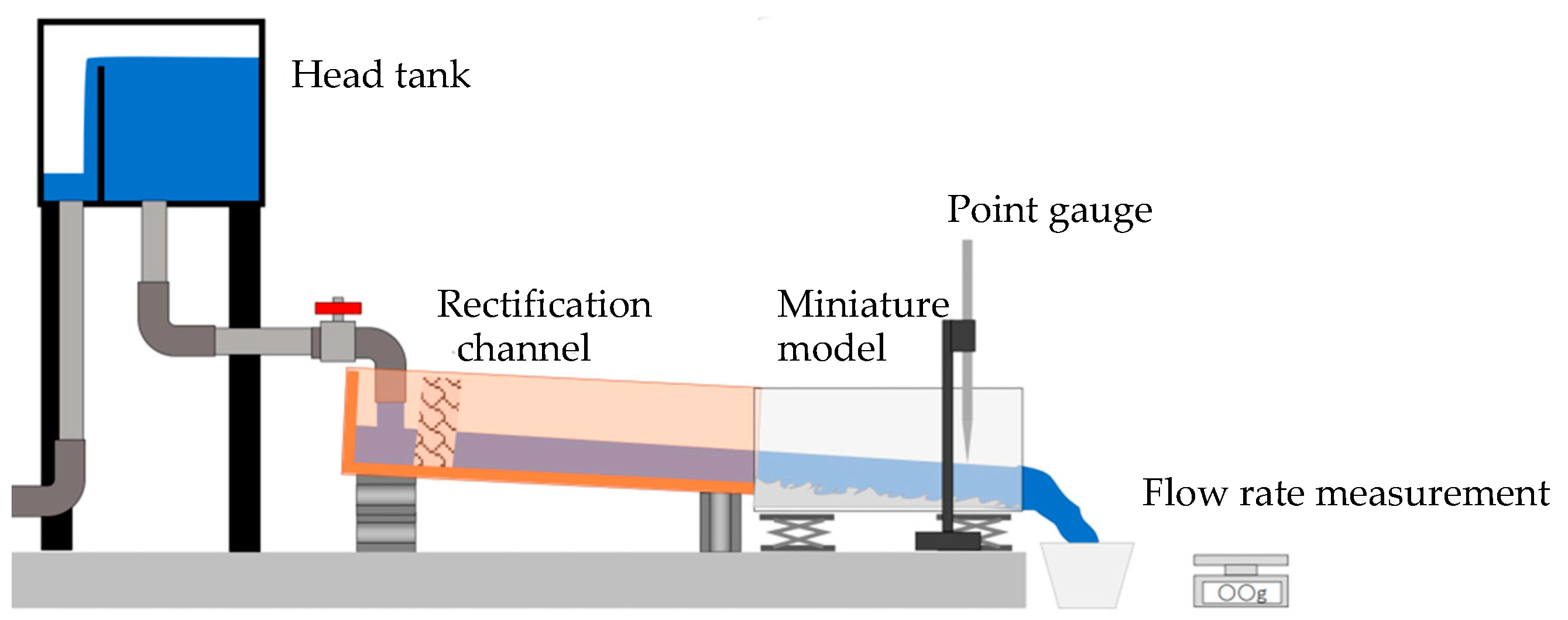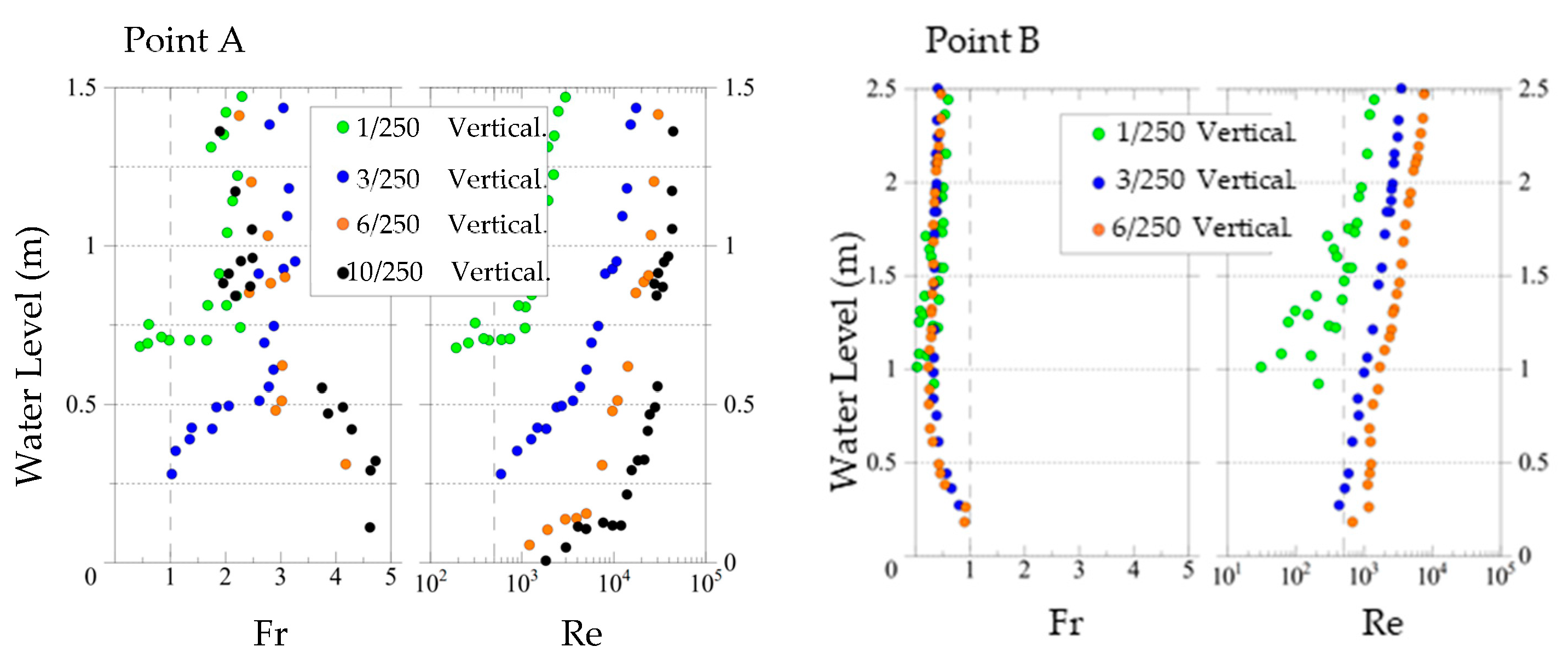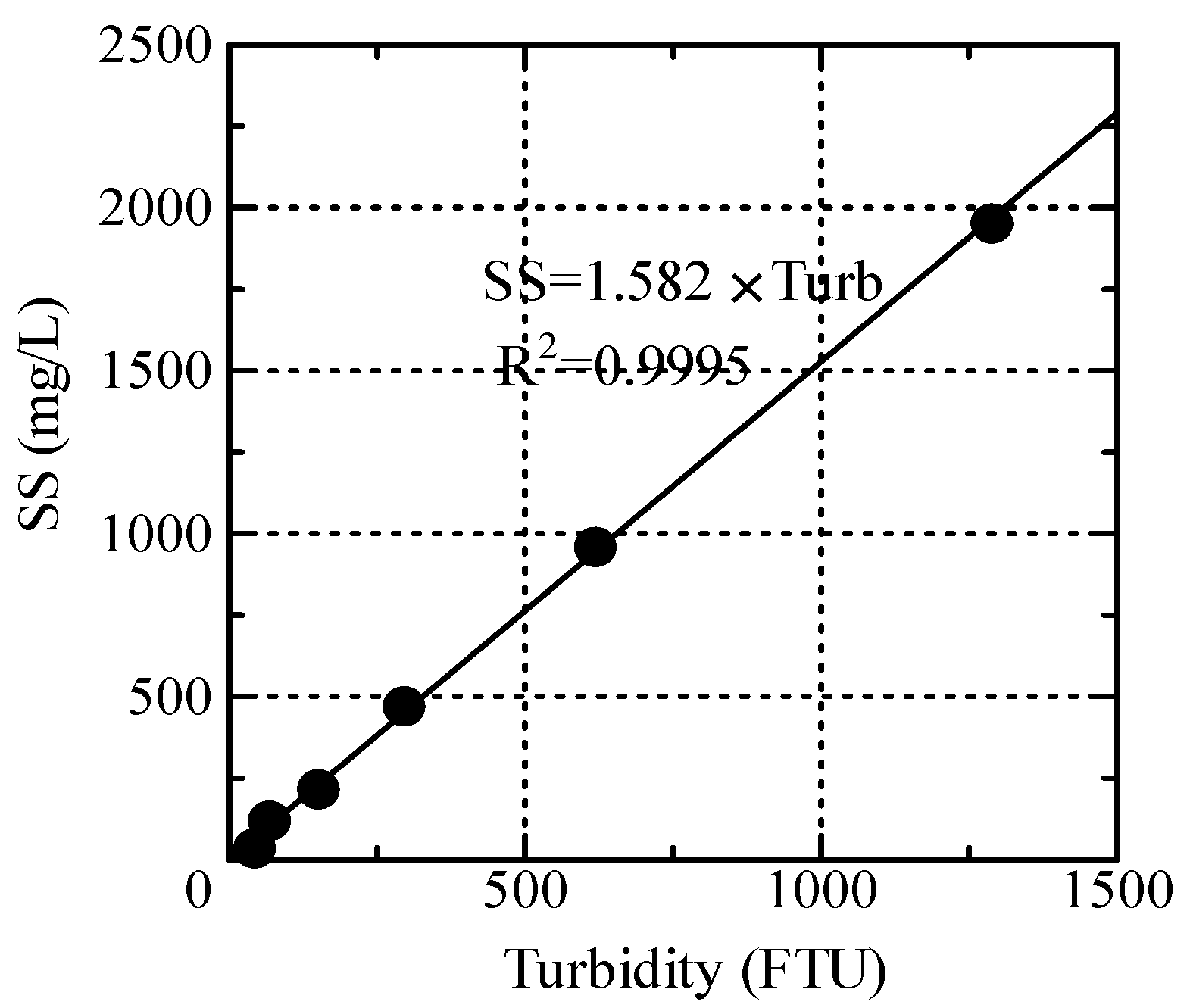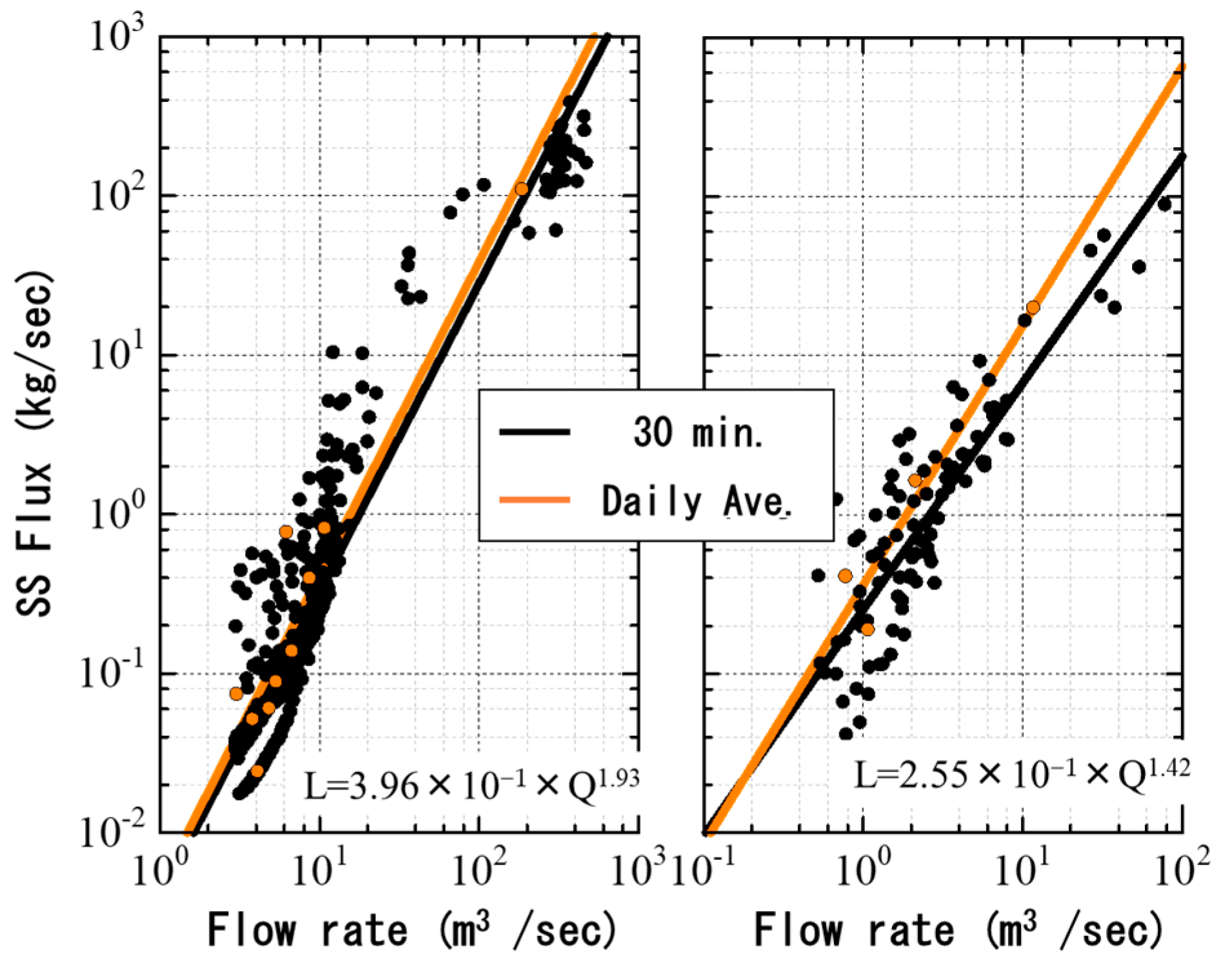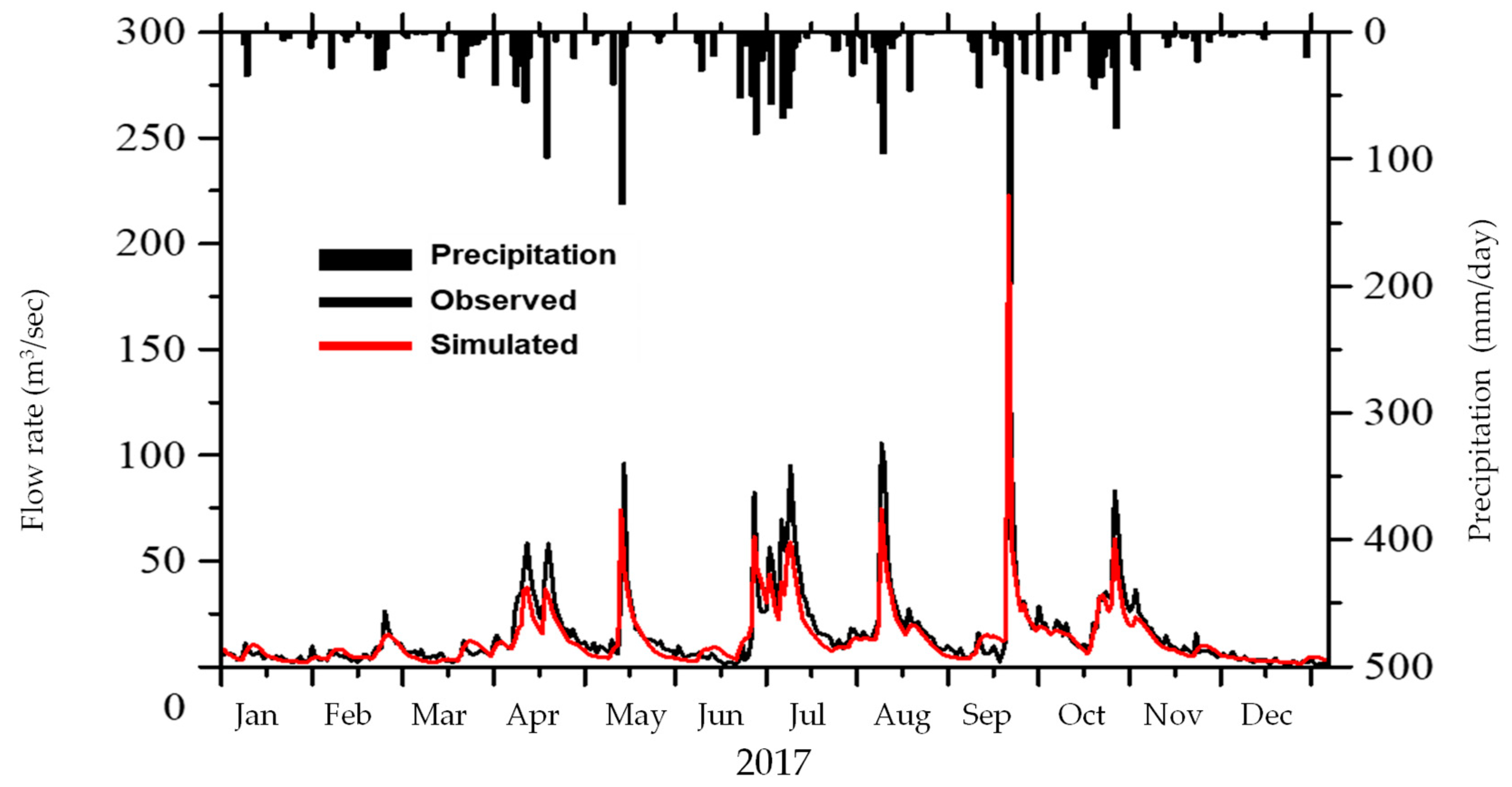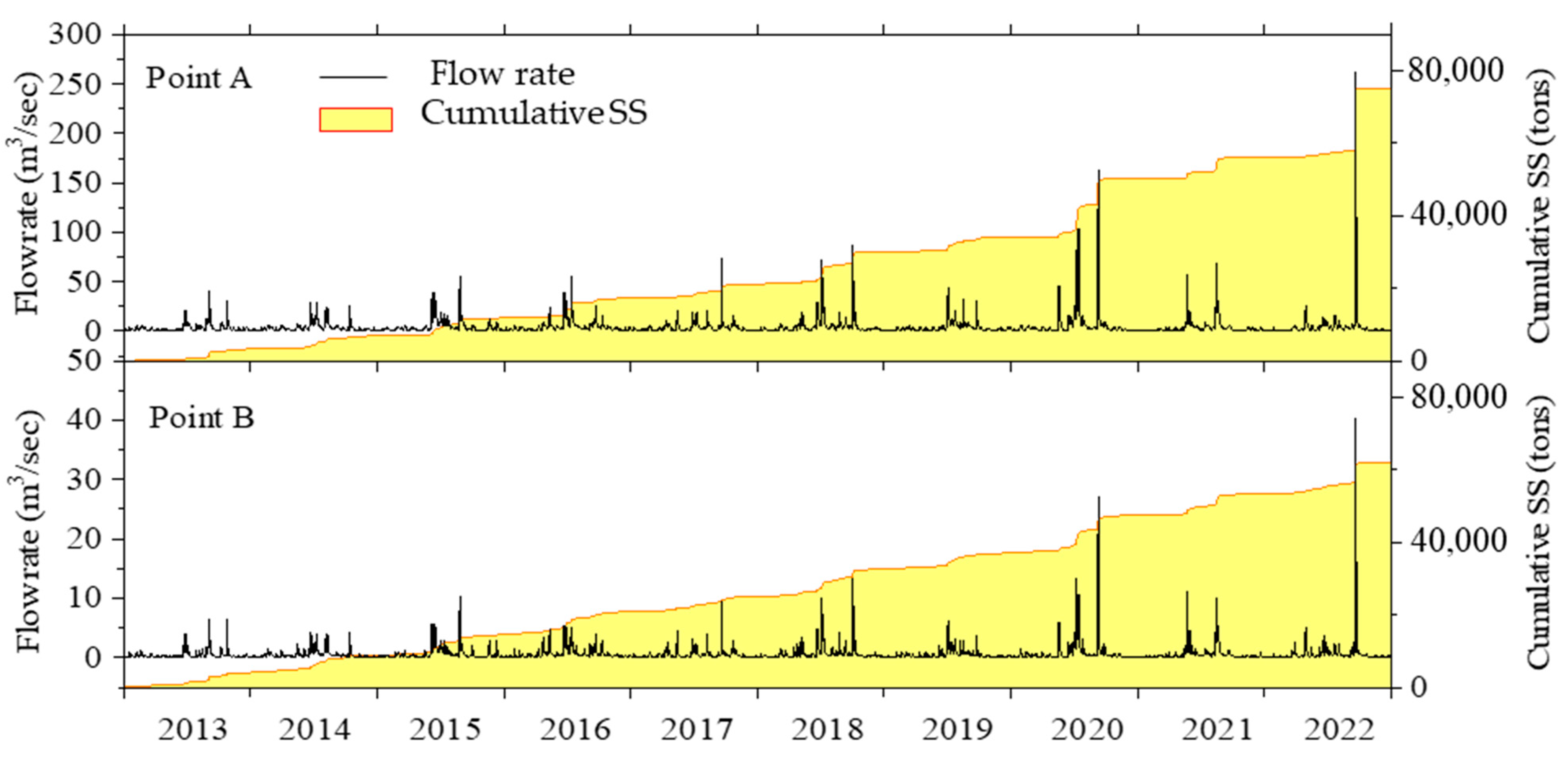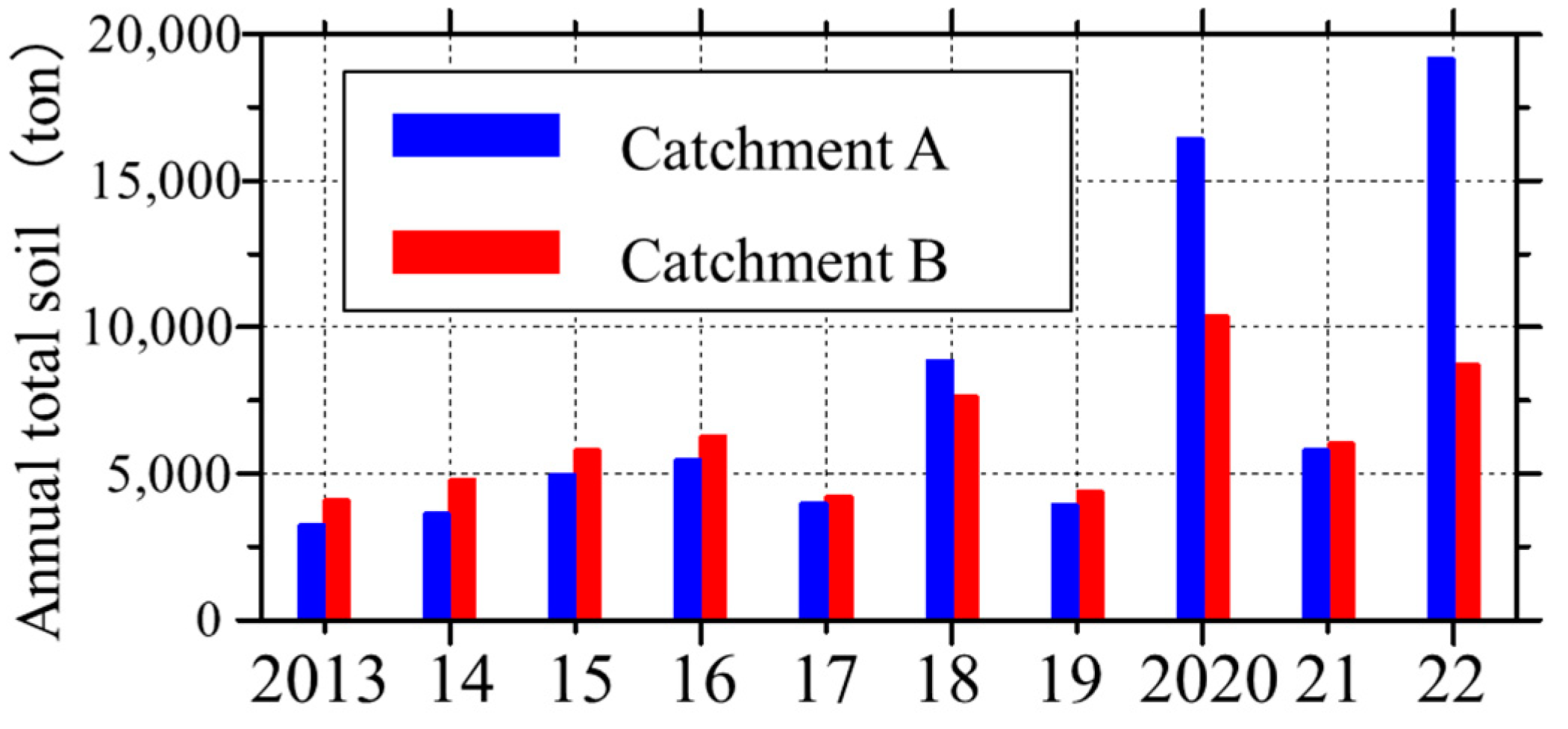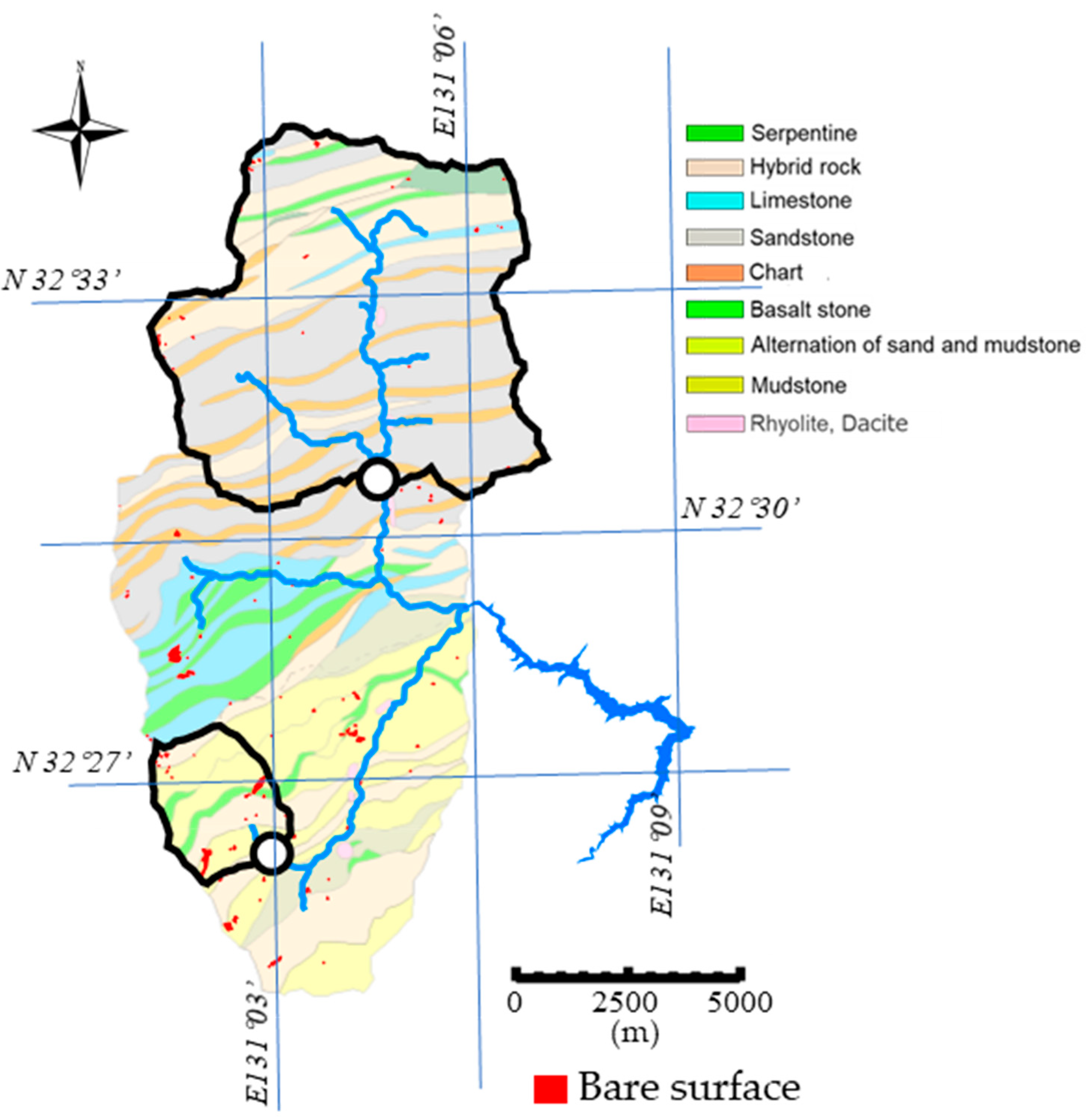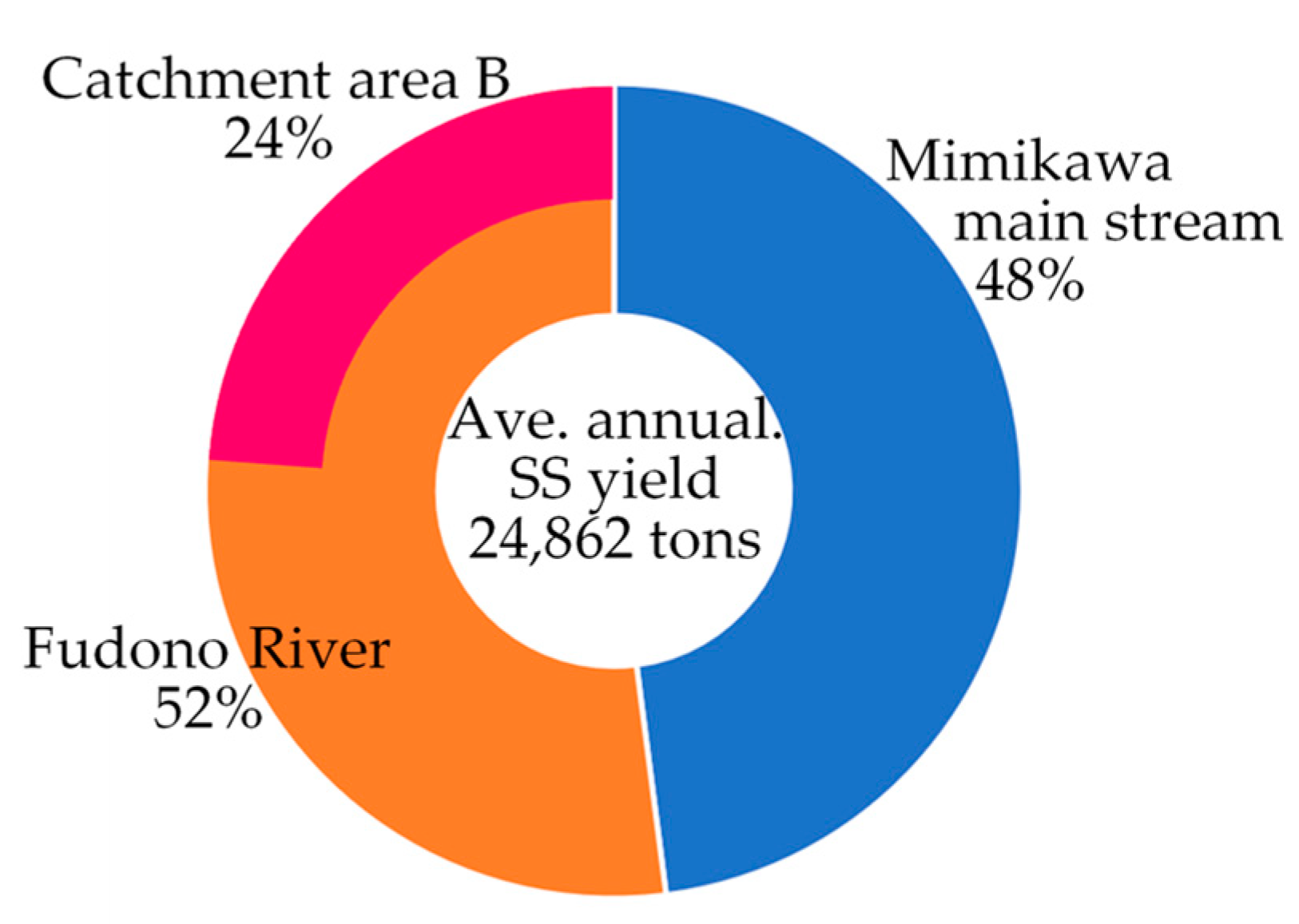1. Introduction
The Kamishiiba Dam, which is located in the uppermost stream of the Mimikawa River system in northern Miyazaki Prefecture, is a power generation dam managed by Kyushu Electric Power Company. Completed in 1995 as Japan’s first large-scale arch-type dam, it has a height of 111 m, a length of 341 m, and a total water storage capacity of 91.55 million m
3. The dam is a power generation dam, without a flood control function, and surface water overflows from an emergency spillway, and is discharged during large-scale floods. At that time, the influent turbid water behaves as a bottom layer density flow, and intrudes into the secondary cline formed near the water intake at a depth of 45 m. Because it is a dam dedicated to power generation, it does not have a large-scale discharge function that can quickly discharge the inflow water from the middle layer at the time of flooding. It is likely to cause the effects of increased turbidity on downstream areas, including not only damage to the landscape of rivers, but also impediments to water treatment, damage to aquatic organisms, and adhesion of soil particles to agricultural products, due to the use of agricultural water. In the “Mimikawa river improvement master plan” [
1], the long-term discharge of turbid water from the dam is listed as an issue that should be tackled. However, there is a limit to the possible elimination of the tendency of turbid water to prolong via changing the dam operation. In general, to deal with the problem of prolonged turbidity, it is conceivable to install a selective water intake facility that discharges the top layer of water downstream, or a bypass tunnel that diverts the turbid water, together with the sediment that flows into it at the time of flooding. The introduction of these countermeasures to the dam would incur enormous costs, and a long construction period.
On the other hand, almost all of the catchment area of Kamishiiba Reservoir is covered by planted forest on steep slopes. Sandstone and shale, and their alternation of the Shimanto Group, which is geologically prone to collapse, are widely distributed [
2]. In addition, the headwater area is located in the central part of Kyushu, and the mountains over 1000 m above sea level centered around Mt. Kunimi and Mt. Ichifusa, which have the heaviest rainfall in Japan, with an annual precipitation exceeding 2000 mm. Due to these topographical, geological, and meteorological conditions, landslides in the forests occur everywhere during rainy seasons [
2,
3,
4]. A large amount of sediment is yielded on the bare surface of the landslides, and it is presumed that large-scale landslides are the main source of turbid water in the basin. To implement countermeasures for controlling the turbid water inflow to the dam intensively, it is necessary to identify the location of the source, and to quantitatively evaluate the amount of soil yield from that source.
There is a case study of identifying the source of turbidity at the Hitotsuse reservoir catchment [
5], adjacent to the Mimikawa River Basin, using the mineralogical tracing method [
6,
7,
8]. The mineral characteristics of the particles vary depending on the area. Tracing the path, and identifying the source of the SSs, is possible through comparing the chemical composition of the sediment particles, and the mineralogical characteristics of the mineral composition. Higashi et al. [
9] collected 13 soil samples from the landslides and the sediments in the river channels in the Kamishiiba dam catchment area, and compared the similarity of the chemical and mineral compositions with the influent turbid water and reservoir sediment, via mineralogical methods. As a result, the authors qualitatively indicated the possibility that the landslide area in the Fudono River basin highly contributed to the total soil yield in the catchment. There is a large-scale landslide with a slope length of about 500 m, and a maximum width of about 150 m, in the Fudono River basin. A large amount of sediment is yielded on the bare surface of the landslides, and it is presumed that large-scale landslides are the main source of turbid water in the basin. However, mineralogical methods only evaluated the similarity in the mineral properties of the sediment collected in the dam and on the slopes in the upstream area, and the SS yield from the local slope could not be quantitatively evaluated. Another quantitative evaluation of the amount of soil yield from the bare surface of the landslide is required in the process of taking measures.
Kawaguchi et al. [
10] also estimated the sediment yield volume from the erosion volume survey. They found that the ratio of the annual volume of sediment runoff between good, well-managed forest land and bare land was about 1:100, and the annual volume of soil erosion on the devastated land surface is 10
1~10
2 m
3/ha/year. Kobayashi et al. [
11] trapped all the eroded sediment from their study plots on the collapsed land with a slope length of about 40 m in the catchment area of Matsukawa Dam, Nagano Prefecture, Japan. The amount of eroded sediment in the landslide area was 857 m
3/ha/year, which was nearly one order larger than that of the previous study. In these studies, not only the fine grain fraction, but also rocks and pebbles, are included in the sediment production, which is different from the focus of our study, which is only on the fine fraction that contributes to the suspension of river water. The geological characteristics of our study site are that the yield of the fine fraction is dominant, and the scale of the landslide area is much larger. A long and fragile steep slope blocks our access, and further collapse should also be considered. It is difficult to carry out surveys of the ground surface at the landslide site.
In this study, a turbidity meter and a water level gauge were installed in the downstream section of the identified landslide site, for the quantitative evaluation of the SS load. There are a lot of examples [
12,
13,
14] of the evaluation of sediment production via on-site observation. However, most of them were carried out at observatories in flat areas that are easily accessible, even at the time of flooding. It is very difficult to build a discharge observation network including points in mountainous areas, in terms of labor and funds, and it is limited to cases such as national projects [
15]. Yokoyama et al. [
13] installed turbidity meters at 17 flow observatories arranged longitudinally along the Chikugo River, to study the characteristics of the SS yield. They found that the SS yield was dominant in the uppermost reaches of steep slopes. However, the flow rate at the uppermost stream was roughly estimated from the morphological outline of the river channel, based on Manning’s equation.
Our study site, the upper reaches of the Kamishiiba reservoir, is also located in a mountainous area that is practically impossible to access during a flooding term, for safety reasons. Even though there are many landslide areas in the forest, and the area is expanding, they only comprise around several percent of the vast water catchment area. On the other hand, as the amount of turbidity produced per unit area is presumed to be extremely high, as mentioned above, an observation point should be placed close to the landslide site, to measure the flow rate and the concentration of the suspended solids (SSs), to thus determine the soil yield. A hydrological model is usually calibrated using stream discharge stations. However, when discharge data are not available, remotely sensed data offer an alternative solution for calibration purposes [
16]. Recent studies proved that the SWAT model can be calibrated using evapotranspiration data, whether actual or estimated from satellite data [
17,
18,
19,
20,
21]. These examples illustrate the application of hydrological models to estimate the water balances over a long term, so that the evapotranspiration could be the validation standard, while this study is concerned with the phenomenon during rainfall, when evapotranspiration is not active.
One of the choices regarding this issue is the application of a distributed run-off model, and the extraction of the simulated discharge at the observatory. A distributed run-off model can be tuned with the discharge data observed over a long term from the larger catchment; for example, at an official observatory, such as the inlet to a reservoir. The discharge from the target small basin in the mountainous area can be extracted from the simulated results of the whole catchment. In the case of the Kamishiiba reservoir, the dam administrator observed the inflow to the reservoir from the upper catchment. However, the extracted discharge data from the small catchment need to be verified using data observed in the field.
In this study, the water level was recorded over a short term, and the equation for the conversion from the water level to the discharge was determined via a hydraulic experiment. Kobatake et al. [
22] built a small-scale model of a check dam, which could be used as a controlling cross-section for discharge measurement in mountainous areas. They obtained a highly accurate relational expression between the water level and discharge through hydraulic experiments with the model. Referring to their experiment, the location of the observatory was selected, focusing on the check dam near the landslide area of our study site. In this study, topographical information about the study sites was obtained using advanced surveying technology and, based on this, the detailed hydraulic model was shaped via a 3D printer. The relationship between the water level and discharge was identified via hydraulic experiments with the model, and the observed water level data were converted to discharge. At the same time, the turbidity was measured at the study sites, the time series of the wash-load flux was obtained, and the relational expression between the flow rate and the wash-load flux was determined. To evaluate the annual average suspended solid yield, the simulated runoff from the small basins over a long term, using the hydrological runoff model, which ensures reproducibility via comparison with the above observation discharge data, was obtained, and the total SS load was estimated, using the relational expression between the wash load flux and the discharge.
2. Material and Methods
2.1. Study Sites
The study sites are in the catchment area of the Kamishiiba reservoir.
Figure 1 shows the geological distribution of the catchment and the two observatories in the two main streams, the Mimikawa River main stream and the Fudono River, respectively. The geological conditions of the catchment areas of each observatory are different. The main geology of the Fudono River catchment is mudstone, and an alternation of sandstone and mudstone, while that of the Mimikawa River main stream is sandstone. The water level gauges (HOBO-U20: Onset Computer Corporation, Bourne, MA, USA) and turbidity meters (INFINITY-CLW: JFE Advantech, Hyogo, Japan) were installed at the points with check dams in the two streams. These instruments started observation on 4 June 2022, but the fixed turbidity meter was moved by the flood of Typhoon No. 14 on 19 September, and the continuity of observation was interrupted. The water level gauge was set to take one measurement every 30 min, and the same gauge was also installed on the ground near the observation points, to compensate for the atmospheric pressure. The turbidity meter worked in burst mode, measuring every 30 min at a frequency of 0.1 Hz. The turbidity meter is a backscattering type, and the measured value is indicated via the formazin turbidity unit (FTU). To prevent the turbidity meter from being affected by suspended obstacles, it was covered with a plastic strainer pipe, with 5 mm holes. Even so, the measured data contain abnormal values, so the lowest value among the six measurements was used as the representative value. At both points, the check dams were filled with sand, and the water was falling through the top of the weir, and the outflow from the drainage holes in the middle of the weir was negligible.
The surveys of the local topography around the check dams were conducted in October 2022. Sediment movement was observed, due to flooding from the large typhoon mentioned above, but the dams were full of sand, and there was no significant change in topography or slope from the situation before the typhoon. The topographic point clouds were obtained via laser scanner (GLS-2200: Topcon, Tokyo, Japan) and UAV-(Matrice-300-RTK: DJI Japan, Tokyo, Japan) mounted LiDAR (Zenmuse-L1: DJI Japan, Japan). The maximum scan speed of the laser scanner was 120,000 points/s, and the distance accuracy was 3.1 mm. LiDAR–UAV can acquire point clouds at an altitude of 100 m, with an accuracy of 3 cm. The correct coordination of the target of the scanner and the base station of real-time kinematic positioning (RTK) for the UAV was obtained using a GNSS receiver (HiPer HR: Topcon), with a horizontal accuracy of 5 mm, and a vertical accuracy of 10 mm. The scanning mode of the LiDAR was a repeat scanning (repeat) pattern, and the return mode was triple, to acquire the topography under the trees. The flight route was set at an altitude of about 80 m, with one survey line in the middle of the river channel, and an additional two survey lines parallel, along the bank. All the acquired point cloud data were synthesized on the same coordinates, using the software MAGNETCollage ver.2.10.0 (Topcon, Japan).
2.2. Preparation of a Miniature Model and Hydraulic Experiment
After creating 3D polygon data from the point clouds, a 3D terrain miniature model was shaped using a 3D printer (Da Vinci 1.0Pro: XYZprinting Japan, Tokyo, Japan).
Figure 2 shows the point clouds acquired at the observation points and the miniature models. The scale was set to 1/250 in the horizontal direction, so that the width of the river channel in the completed model would be about 30 cm. As the maximum possible modeling size using the 3D printer is 20 × 20 cm, the polygon data were divided into several parts, and joined together after each shaping. The Tough PLA was used as the filament for the 3D printer, which has excellent processability, less heat shrinkage, and less warping after shaping. Due to the extremely small model, the water depth becomes very shallow, and there is concern that the viscosity will greatly affect the results. To reduce the effect of the viscosity, and facilitate the water level measurement, distorted models, which have a larger scale in the vertical direction (3/250, 6/250, 10/250), were also prepared.
Figure 3 shows an overview of the experimental hydraulic channel. The upper end of the miniature model was connected to a rectification channel that had the same gradient as the average gradient of the models. The water level was measured with a resolution of 10
−2 mm, via the placing of a point gauge at the same location as the water level gauge in the field. The discharges measured in the experiments were converted to the discharge in the actual scale, based on Froude’s law of similarity. The relationship between the water level and the discharge in the actual scale was obtained for each model.
Figure 4 shows the relationships between the water level (H) and the discharge (Q) of each site, obtained from the hydraulic experiment.
Figure 5 shows the relationship between the water level in each case and the Froude number or Reynolds number, which are estimated from the cross-sectional average flow velocity, and the water depth over the weir.
Regarding the relationship between the water level and the discharge at point A, the results of the non-distorted model, with a 1/250 scale in the vertical direction, show a slightly higher water level than that using the distorted scales for the same discharge. It is considered that the Reynolds number is small at low water levels, the viscosity is dominant, and the flow is laminar. On the other hand, the water depth of the distorted models is relatively large, and their Reynolds numbers exceed 500, which is the threshold between the laminar flow and the transition region. The natural river flow in the field is turbulent, so the Reynolds numbers in the experiment are required to exceed 500, meaning that the results of the non-distorted model could not duplicate the actual flow. The Froude numbers are all greater than 1, indicating a rapid state. In other words, the check dam does not function as a control section, and is affected by the gradient and roughness of the upstream side. A larger-scale distorted model naturally has a larger gradient, so it is thought that a distorted model with a smaller scale represents the actual situation better. Finally, the H–Q relation obtained from the model with the vertical scale of 3/250 was used for point A. Its R2 was 0.88.
Concerning the relationship between the water levels and the discharges at point B, the results with vertical scales of 3/250 and 6/250 show good agreement, while those of the non-distorted model are scattered, especially for the low-water-level range less than 1.5 m. This is also due to the strong influence of the viscosity. When the flow rate and water level are increased with the distorted models, the relationship is almost the same as in the other cases. It can be seen that the check dam functions as a controlling section. Both sides of the check dam at point B are high, and the width of the flow narrows above the dam, resulting in a laminar flow. Finally, the relationship between the water level and the discharge for point B, obtained from the distorted models with the vertical scales of 6/250 and 3/250, was used for the conversion from the water level observed in the field to the estimated discharge. Its R2 was 0.99.
2.3. Run-Off Simulation and Validation
The Soil and Water Assessment Tool (SWAT) [
23] model (ArcSWAT 2012.10_2.18) was used for the simulation of the discharge over the long term. The parameters of the model were adjusted via SWAT–CUP [
17], based on the inflow of the dam management daily report for the entire Kamishiiba Dam catchment area for 2017, when the observed data were provided by the electric power company. To assess the performance of the SWAT model, three of the most commonly used statistical indices were selected: the Nash–Sutcliffe efficiency (
NSE) [
24], the percent bias (
PBIAS), and the coefficient of determination (
R2), as shown in Equations (1)–(3), respectively. The calibrated result was validated with
where
and
are the observed and simulated flow rate values.
and
are the average observed and simulated flow rate values, and n is the total number of observations. The NSE ranges from −∞ to 1, where 1 is the optimal value, PBIAS is the mass balance error in percent, with 0 being the optical value, and R
2 ranges from 0 to 1, with 1 being the optimal value, respectively.
4. Conclusions
In this study, focusing on the large landslide area, which was suspected to be the source of the SSs supplying long-term turbidity to the Kamishiiba Dam in the previous study, the annual average soil yield from a unit area of the bare surface of each geological condition was evaluated. The study site is in a deeply mountainous area, so it is difficult to access the location for the measurement of the flow rate in situ, which is needed for the calibration/validation of runoff simulations, and the identification of correlations with the turbidity load. In this study, the relationship between the water levels and the discharges was identified via hydraulic experiments, using a hydraulic model reflecting the detailed topography of the observatory. The measured water level was converted to discharge via the identified relationship with the models. Based on the results of the long-term runoff simulation, verified with the flow rate time series as mentioned above, the relational expression between the discharge and SS load, the annual average SS yield from a unit area of the bare surfaces were calculated. As a result of the alternating layer of sandstone and mudstone, including the large landslide, the SS production rate is large. In addition, a high number of landslides were found intensively in that formation, so there is a possibility that the amount of SS production in the catchment can be greatly reduced via intensive measures, such as fixing the topsoil of the bare surface.
With distributed runoff models, it is possible to extract the runoff of some small basins from the analysis results, but they have been difficult to validate. This study showed that the measured water level was converted to discharge using a hydraulic model that reproduces the local topography with a high accuracy, and that it was used for the verification of the discharge data extracted from the hydrological model. At the same time, the relationship with the SS load, based on the turbidity measured, was also identified and, together with the long-term runoff analysis results, the annual average SS production intensity could be evaluated. The series of processes using the hydraulic model and hydrological model presented in this study is a new runoff evaluation method for mountainous areas, where discharge observation is not conducted, due to access reasons.


